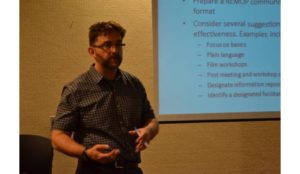Radiation monitoring and education program gets underway in Burke County
Thomas Gardiner
Augusta Chronicle
Contact: (706) 823-3339 or thomas.gardiner@augustachronicle.com
Posted June 20, 2017 05:51 p.m. – Updated June 21, 2017 01:14 a.m.

Studies in the 1990s revealed a number of drinking wells around Burke County with tritium contamination, a radioactive product of the Savannah River Site. Studies also suggest the area has had higher than average cancer rates since the establishment of Plant Vogtle, leaving some residents with questions about radiation exposure from entities positioned adjacent to each other along the Savannah River.The Environmental Protection Agency held a public forum Monday to announce the results of a needs assessment conducted in late 2016 to establish the Radiological Education, Monitoring, and Outreach Program. The agency is working in conjunction with Georgia Women’s Action for New Direction and Savannah River Ecology Laboratory to initiate the outreach program.
According to the ecology lab, the program will provide Burke County residents with information about radionuclides and heavy metals during a one-year testing cycle of the soil, water, local domestic meat sources, and wildlife. The organizations are forming a community advisory committee to gather input from residents.
“SREL plans to talk to the community advisory committee to determine what comes next and will use data collected from systems that already exist,” said Dr. Gene Rhodes, the lab’s director.
Some community residents and advocates, though, pointed to shortfalls in the program’s early implementation.
“I don’t see the landowners along the river or the fishermen represented here,” Savannah Riverkeeper Executive Director Tonya Bonitatibus said. “We need to include everyone; especially those we know are eating the fish and game.”
A group of local residents agreed. EPA representative Robert Hope said the proper course of action is to work with community leaders, hold open meetings, and get into the hard to reach places so the program can include all county residents.
According to Bonitatibus, research is slim when trying to correlate area cancer rates to nuclear exposure, especially concerning tritium.
“There’s just not a lot of research published about tritium exposure and how it relates to cancer,” she said. “Monitoring and education only go so far when you don’t have the data to figure out the problem.”
According to Georgia WAND Executive Director Becky Rafter, the Burke County issues are a public health concern.
“When we went to the Department of Energy to get funding, the proposal originally had a public health component,” she said. “Since DOE doesn’t fund public health, we have pulled that and are looking to outside funding to find that component.”
Megan Winzeler runs the Shell Bluff outreach program for the lab. She said the program will need community volunteers to be successful and has developed a program to get some younger residents involved.
“I am working with Burke County Middle School seventh grade teachers to develop a partnership,” she said. “We want to get the students involved and give them real-world experience for what they learn in the classroom. We want to take them out to get samples from soil and test them.”
Winzeler said the plan is to keep the program in line with Georgia education requirements in physical science for seventh grade students.
“The crux of the project is making sure everyone in the community knows,” Winzeler said.
According to the EPA, SRS is a priority and has been classified by the South Carolina Department of Health and Environmental Control as one of the most dangerous threats to the state’s environment. The EPA and the lab will begin a series of educational workshops in Waynesboro beginning July 24, with informative class sessions established into late August.
“The EPA plays a role in this project because SRS is a high priority site, and this is one of the communities affected by their nuclear activities,” he said.
The first Community Advisory Committee meeting will be held later in the month in Waynesboro. The year-long education program begins in July and the lab’s representatives expect radiation and contamination fact sheets to be ready in coming weeks.
